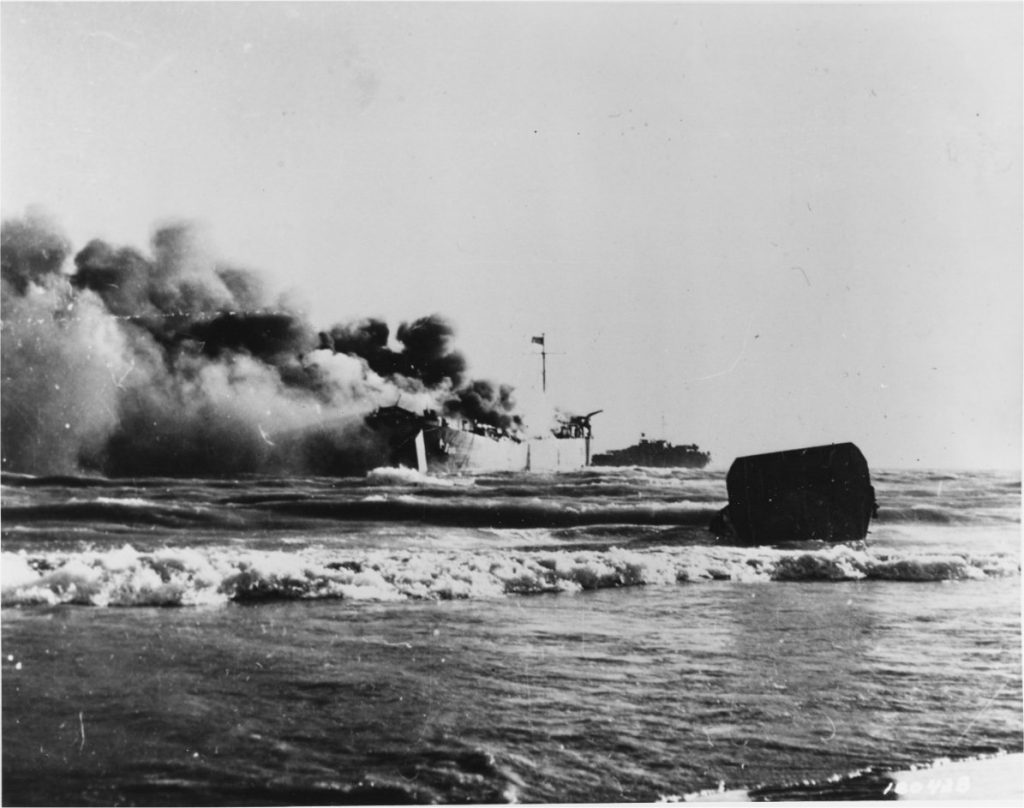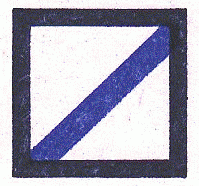The Operations Record Book of No. 3 R.A.F. Auxiliary Embarkation Unit (later No.83 R.A.F. Embarkation Unit) has a little slip of paper on the front that says simply, “Original Record Destroyed By Enemy Action” and the first sheet of the record is hand written on plain paper rather than on the printed R.A.F. Form 530 normally used……
No. 3 R.A.F. Auxiliary Embarkation Unit is formed.
On 23rd May 1943, No. 3 Auxiliary Embarkation Unit was formed at the Base Personnel Depot in Algiers. The new Unit boarded a train on 1st June and travelled to Oran, arriving on 3rd June. Next day, Flight Lieutenant Hayward, Commanding Officer of the Unit, reported to 1st Engineer Special Brigade, U.S. Army at Port Aux Poules.
On 5th June, the Unit was divided into ‘A’ and ‘B’ Parties under F/Lt Hayward and F/Lt Whiteley respectively. Each party consisted of one officer and eleven men. The intention was for each party to be attached to a battalion of 531st Engineer Shore Regiment, U.S. Army, “for training in beach landings and beach technique and discipline”. Next day, ‘A’ Party reported to 2nd Battalion at Bou Sfer and ‘B’ Party reported to 3rd Battalion near Arzew.
The two parties of No. 3 A.E.U. had four days of training with the Americans and then, on 11th June, after a 14 mile route march to Oran, they embarked on U.S.S. Barnett for Algiers. Landing was made at Algiers on 13th June and the units went to Foret De Bainon.
Over the next eleven days there were conferences and planning for the forthcoming Operation HUSKY. F/Lt Hayward visited Force 141, met W/Cdr Maggs and W/Cdr George, and received a briefing for the Operation and sealed instructions.
On 25th June 1943 the Unit embarked on L.C.I. 75 for an “unknown destination”. That destination proved to be Tunis, where they arrived on 3rd July.
On 4th July No. 3 A.E.U. was transferred from Northwest African Air Force (N.A.A.F.) to Middle East Command, under the operational control of Desert Air Force (D.A.F.). The Units function in Operation HUSKY was to act as an “R.A.F. Beach Brick attached to 531st Engineer Shore Regiment, United States Army, to supervise off loading, on beaches, of R.A.F. stores and supplies.”
On 6th July, the Unit’s ‘A’ Party under command of F/Lt Hayward embarked on an L.C.I. and the ‘B’ Party under F/Lt Whiteley embarked on an L.S.T. They sailed to Sousse, arriving at 10am next day and then sailed again the day after, 8th July, bound for Sicily.
Invasion Of Sicily
At 5.30am on 10th July 1943, D-Day for Operation HUSKY, the ‘A’ Party of No. 3 A.E.U.landed on the beaches east of Gela with no casualties.
“As the fighting was being taken further inland, dumps were set up over sand dunes about ½ mile from the beach and ‘A’ Party moved in. Enemy air activity was heavy and the area was still under long range shellfire.”
During the evening of D-Day, the L.S.T. on which the Unit vehicles and equipment had been sent was destroyed by bombing. One of the Unit’s drivers and a motorcyclist were reported missing.
The bombed L.S.T. was, almost certainly L.S.T. 313. The incident is described by Christopher Miskimon as follows.
“At 1835 another Me-109 appeared, flying out of the setting sun. The pilot chose LST 313 as its target. Its bomb exploded under the tank deck and started a huge fire, which engulfed the ship. Soldiers and sailors swam out to the stricken ship to help wounded off its bow ramp. The captain of LST 311, Lieutenant Robert L. Coleman, pulled his ship around so his bow connected with the stern of LST 313. This allowed 80 trapped men to escape the flames. Still, 21 were lost.”
See ‘Bitter Fight at Gela’

US Army Signal Corps photo in the collections of the US National Archives (photo # SC 180428).
Enemy bombing and strafing continued during the night.
On D+1 there was a counter attack by the Herman Goring Division.
“The enemy broke through with tanks & attacked the dump areas and an ugly threat was made to the actual beach. ‘A’ party retired to the beaches, having behaved well under their baptism of fire and that from tanks only ¼ mile away. The attack was beaten off, and new dump areas set up.”
Due to heavy fire on the beach where they were intended to land, the ‘B’ party of No. 3 A.E.U. were landed at Scoglitti and had to march eight miles from there to take up positions on the beaches to the right of ‘A’ Party.
The driver reported missing from the bombed L.S.T. was picked up by another boat and brought to the shore. The motor-cyclist was reported to have been transferred to a hospital ship “with unknown injuries”.
The situation settled down and from 12th July to 3rd August the Unit was engaged in general supply and liaison duties at Gela with the American Air Corps, III A.S.A.C. Visits were made to Colonel Abrahams at 15th Army Group, Group Captain Reid, Air Ministry and Wing Commander George, N.A.T.A.F. Movements.
At the end of July they were joined briefly in Gela, by Nos. 1 & 2 Auxiliary Embarkation Units while those Units were waiting to return to North Africa.
On 4th August the ‘B’ Party of No. 3 A.E.U. moved to Licata to help the Americans with the unloading of bombs. The ‘A’ Party remained at Gela for embarkation duties in connection with the arrival of Tactical Air Force units and supplies.
No. 83 Embarkation Unit
On 5th August 1943, while in Sicily following Operation HUSKY, No. 3 Auxiliary Embarkation Unit was renamed as No. 83 Embarkation Unit. The whole Unit moved to Dittaino on 23rd August to supervise supplies from the railhead to the Gerbini airfields and then, on 30th August the Unit moved to Milazzo for embarkation duties.
Throughout September 1943, the Unit was again divided into ‘A’ and ‘B’ Parties. ‘A’ Party supervised the R.A.F. and U.S.A.A.F Assembly Area at Milazzo and the ‘B’ Party acted as R.A.F. Movement Control at the docks.
During this month units of the R.A.F. and U.S.A.A.F. units were assembled and despatched to the Salerno area in Italy for Operation AVALANCHE. There was no enemy air activity in the Milazzo area and the weather conditions were “excellent”.
The duties of No. 83 E.U. at the port and assembly areas at Milazzo continued into October and then on 10th October, the Unit was ordered to go to Catania to assist the R.A.F. Component of 31 Beach Brick which was acting as an R.A.F. Embarkation Unit at that port. The Unit assisted at Catania for the rest of the month.
On 20th October F/Lt Whiteley flew to H.Q. T.A.F. for a conference with W/Cdr George about future policy regarding R.A.F. Beach Units in the Mediterranean theatre. At the end of October 1943, No. 83 R.A.F. Embarkation Unit was “awaiting instructions from higher formation”.
Like the other R.A.F. beach units formed in North Africa and the Middle East in 1943, No. 83 R.A.F. Embarkation Unit was disbanded. Some of the Unit personnel would be posted to the new R.A.F. Beach Group that was formed, later to be named No. 5 R.A.F. Beach Unit.
Main source used for this page:
Operations Record Book of No. 3 RAF Auxiliary Embarkation Unit – found in, ‘Air Ministry and Ministry of Defence: Operations Record Books, Miscellaneous Units’ AIR 29/438 at The National Archives.
All quotes, unless otherwise indicated, are from this source.
